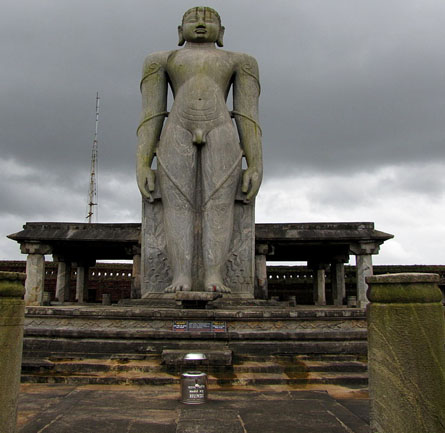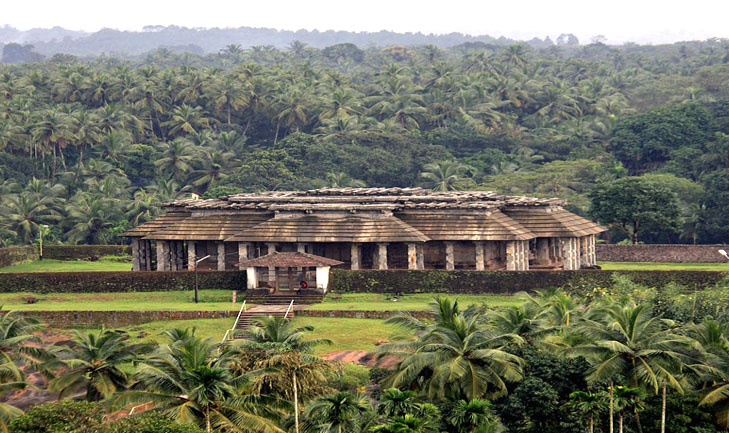Gommata Jain Tirth - Karnataka
 |
The Gommateshwara statue of Karkala, inspired by the one at Sravanabelagola, is a testimony to the devotion of the Jain kings of Karnataka.
Awe-inspiring symmetry : The Chaturmukha Basadi at Karkala. The breathtakingly lifelike statue of Gommateshwara cradled in enchanting natural scenery is well worth the steep, 200-step ascent to this awe-inspiring structure. Owing to the good maintenance by the Archaeological Survey of India, this structure of the Bahubali, along with the Chaturmukha Basadi, the Neminatha Basadi and the Ananthasayana temple, serves as a token of great pride to the Karkala district of Karnataka. Over 3.5 lakhs of rupees have been spent to preserve the statue in the past 5 years, thus giving a fillip to the region's tourism.
Records from the past-the glorious history of this district and its temples are described in great detail in 1,000-year-old scriptures, which are valuable treasures of the Jain religion. Currently in the possession of Lalithakeertha Swamiji, a patron of Jain Culture in the district, the scriptures have words of wisdom and tradition etched on dried leaves, preserved in perfect condition over the centuries. These scriptures are made available on request.
Situated northeast of Mangalore, the Gommata statute is nearly 600 years old and is the second tallest statue in Karnataka. Interestingly, this serene, 45-feet structure was carved out of a single granite-rock found near the surrounding hills and later dragged up the hillock and erected. The scriptures indicate that it took over a year for horses, elephants and men to lug this structure atop the hillock. Veerapandya Bhairarasa installed it to pay tribute to the Jains of that area, after being inspired by the lofty statue in Sravanabelagola, the tallest in the State.
The Bhramadevara Stambha is the granite pillar standing in front of the Gommata. This pillar has a small structure of Brahma carved on the top. Installed five years after the statue itself, it excels the Gommata in sculptural detail. Also called the Kshetrapala, this structure is believed to be the protector of the temple and its surroundings. Behind the Bahubali statue is a 12-pillared *mantap*, where ceremonies are usually performed.
Serene surroundings The statue of Gommateshwara is surrounded by striking landscape on all four sides. The picturesque Ramasamudra lake lies nestled between the Chaturmukha hills. This lake is an artificial reservoir, which remains as the main source of water supply to the locals even today. On the other side of the valley is the Chaturmukha Basadi, named so because of its four identical entrances from the different directions. Rumour has it that Bhairarasa attempted in vain to build a bridge across the hills to interlock this Basadi with the Gommata statue. One can only imagine the splendour that would have resulted if he had succeeded.
A place for the saints The Chaturmukha Basadi, an important place of worship for the local Jains, was built in the late 16th century by Veeranarsimha Banga. It houses life-size statues of three revered Tirthankaras, Ara, Malli and Munisuvrata, as well as images of the other Jain saints. The Basadi has 48 pillars inside the Garbagriha and 60 pillars outside the entrances. It took over 30 years to build the Basadi. The statue of Brahma standing with the female figure of the Padmavati Yakshi is also seen in the eastern side of the Basadi.
The Karkala district and surrounding areas of Vennoor, Dharmasthala and Moodbidri serve as home to more than 800 Jain families. It is a very important cultural and religious centre of southern India. The art-forms exhibited in various Jain temples are a source of architectural brilliance. "The locals of the district engage in many religious activities," says Lalithakeertha Swamiji. "The Mastabhishek that takes place once every 12 years in all these centres rakes in contributions from many devotees and people gather in huge numbers to witness this magnificent event," he adds. "The common belief is that one is cleansed of all sins committed in the last decade if he or she witnesses this celebration." Jains from places as far as Jaipur come down to be a part of the month-long festivities and rituals of the Mastabhishek. Held last in 2002, this ceremony witnessed scores of devotees from all the regions of the country.
Across religions A major component of the population of Karkala is the families of the Goan refugees who fled Portuguese invasion in the early 16th century. Kings like Bhairarasa, Veeranarasimha and their descendants opened their doors to these immigrants. The Jain kings also built Hindu temples to enable them to pursue their ancient mode of worship. So, a deep sense of attachment to these monuments built by the kings is seen not only among the Karkala Jains but also among other non-Jain locals of the region.
 |
-----------------------------------------------------
Courtesy : Mr. Gaurav Jain 'Lakshaya, Mob : (+91) - 9811981233 (+91) - 9811981233
-----------------------------------------------------
Mail to : Ahimsa Foundation
www.jainsamaj.org
R040807